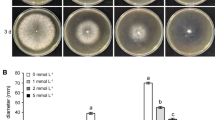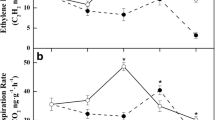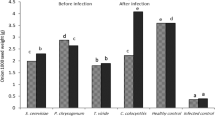Abstract
Trichothecium roseum is a major postharvest pathogenic fungus, which can infect apple, muskmelon, tomato and other fruit and vegetables, resulting in postharvest diseases. T. roseum infection not only leads to considerable economic losses, but also accumulates mycotoxins, posing a threat to human’s health. Phospholipase D (PLD), as an important phospholipid hydrolase, accelerating the infection of pathogens by damaging the structure of the cell membrane. Therefore, PLD plays a crucial role during pathogen-host interactions. In this study the effect of 1-butanol (a PLD specific inhibitor) treatment on the growth of T. roseum and the pathogenicity on muskmelon fruit was evaluated in this study. T. roseum was treated with PLD inhibitor 1-butanol at concentrations of 0.125%, 0.25%, 0.5% and 1.0%. Spore germination, germ tube length, hyphal growth, colony diameter, sporulation, conidial morphology were assessed in vitro. The pathogenicity of T. roseum on muskmelon fruit, as well as the genes expression and activity of PLD were determined during T. roseum infection of muskmelon. The results indicated that 0.5% 1-butanol significantly inhibited spore germination, germ tube length, hyphal growth, and sporulation of T. roseum.. Moreover, 1-butanol treatment significantly suppressed lesion expansion of inoculated muskmelon fruit, when compared with the control group, the PLD activity was reduced in fruits treated with 0.5% 1-butanol. TrPLD gene expression analysis suggested that there are four family genes of TrPLD1, TrPLD2, TrPLD3, and TrPLD4, the four TrPLDs were significantly down-regulated after 0.5% 1-butanol application, among which, TrPLD3 played a more crucial role than the other three genes. The results suggested that specific inhibitor 1-butanol treatment decreased the pathogenicity of T. roseum on muskmelon fruit by suppressing the growth of T. roseum, and down-regulating TrPLD gene expression and reducing the activity of PLD.






Similar content being viewed by others
References
Alejandra, V. F., Álvaro, P., Laura, R. J., Antonio, D. V., Alejandro, P. G., & Dolores, F. O. (2020). Fungicide resistance in powdery mildew fungi. Microorganisms, 8, 1431–1431. https://doi.org/10.3390/microorganisms8091431
Ding, M. Y., Zhu, Q. L., Liang, Y. S., Li, J., Fan, X. Y., Yu, X. Y., He, F., Xu, H. J., Liang, Y. C., & Yu, J. F. (2017). Differential roles of three FgPLD genes in regulating development and pathogenicity in Fusarium graminearum. Fungal Genetics and Biology, 109, 46–52. https://doi.org/10.1016/j.fgb.2017.10.007
Fan, C. X., Wang, J. J., Peng, Q. D., & Wang, P. (2019). Identification of fungal pathogen causing pink rot of muskmelons and inhibitory effects of three chemicals on the fungal pathogen in vitro. Science and Technology of Food Industry, 40, 78–83. https://doi.org/10.13386/j.issn1002-0306.2019.13.013. (In Chinese).
Gong, A. D., Dong, F. Y., Hu, M. J., Kong, X. W., Wei, F. F., Gong, S. J., Zhang, Y. M., Zhang, J. B., Wu, A. B., & Liao, Y. C. (2019a). Antifungal activity of volatile emitted from Enterobacter asburiae Vt-7 against Aspergillus flavus and aflatoxins in peanuts during storage. Food Control, 106, 106718–106718. https://doi.org/10.1016/j.foodcont.2019.106718
Gong, D., Bi, Y., Li, S. E., Li, Y. C., & Wang, Y. (2019b). Trichothecium roseum infection promotes ripening of harvested muskmelon fruits and induces the release of specific volatile compound. Journal of Plant Pathology, 101, 529–538. https://doi.org/10.1007/s42161-018-00231-0
Hassing, B., Eaton, C. J., Winter, D., Green, K. A., Brandt, U., Savoian, M. S., Mesarich, C. H., Fleissner, A., & Scott, B. (2020). Phosphatidic acid produced by phospholipase D is required for hyphal cell-cell fusion and fungal-plant symbiosis. Molecular Microbiology, 113, 1101–1121. https://doi.org/10.1111/mmi.14480
Hong, Y. Y., Zhao, J., Guo, L., Kim, S. C., Deng, X. J., Wang, G. L., Zhang, G. Y., Li, M. Y., & Wang, X. M. (2016). Plant phospholipases D and C and their diverse functions in stress responses. Progress in Lipid Research, 62, 55–74. https://doi.org/10.1016/j.plipres.2016.01.002
Jimdjio, C. K., Xue, H. L., Bi, Y., Nan, M. N., Li, L., Zhang, R., Liu, Q. L., & Pu, L. M. (2021). Effect of ambient pH on growth, pathogenicity, and patulin production of Penicillium expansum. Toxins, 13, 550–550. https://doi.org/10.3390/TOXINS13080550
Jincy, M., Djanaguiraman, M., Jeyakumar, P., Subramanian, K. S., Jayasankar, S., & Paliyath, G. (2017). Inhibition of phospholipase D enzyme activity through hexanal leads to delayed mango (Mangifera indica L.) fruit ripening through changes in oxidants and antioxidant enzymes activity. Scientia Horticulturae, 218, 316–325. https://doi.org/10.1016/j.scienta.2017.02.026
Kong, W. L., Rui, L., Ni, H., & Wu, X. Q. (2020). Antifungal effects of volatile organic compounds produced by Rahnella aquatilis JZ-GX1 against Colletotrichum gloeosporioides in liriodendron chinense × tulipifera. Frontiers in Microbiology, 11, 1114. https://doi.org/10.3389/fmicb.2020.01114
Li, L., Li, J. M., Sun, J., Li, C. B., Sheng, J. F., Zheng, F. J., Liao, F., He, X. M., Liu, G. M., Ling, D. N., & You, X. R. (2015). Effects of 2-butanol on quality and physiological characteristics of longan fruit stored at ambient temperature. Postharvest Biology and Technology, 101, 96–102. https://doi.org/10.1016/j.postharvbio.2014.12.002
Li, L., Li, J. M., Sun, J., Li, C. B., Ling, D. N., Sheng, J. F., Zheng, F. J., He, X. M., Liu, G. M., Xin, M., Li, Z. C., & Ran, D. H. (2017). Effects of 2-butanol on characteristics of postharvest longan fruits stored under low temperature. Journal of Southern Agriculture, 48, 2247–2252. https://doi.org/10.3969/j.issn.2095-1191.2017.12.21. (In Chinese).
Li, X., Li, B. H., Lian, S., Dong, X. L., Wang, C. X., & Liang, W. X. (2019). Effects of temperature, moisture and nutrition on conidial germination, survival, colonization and sporulation of Trichothecium roseum. European Journal of Plant Pathology, 153, 557–570. https://doi.org/10.1007/s10658-018-1583-8
Li, J. F., Zhou, G., Wang, T., Lin, T., & Ma, G. B. (2021). First report of Pseudomonas oryzihabitans causing stem and leaf rot on muskmelon in China. Plant Disease, 105, 2713–2713. https://doi.org/10.1094/pdis-01-21-0100-pdn
Livak, K. J., & Schmittgen, T. D. (2001). Analysis of relative gene expression data using real-time quantitative PCR and the 2 −ΔΔ C T method. Methods, 25, 402–408. https://doi.org/10.1006/meth.2001.1262
Ma, D. Y., Ji, D. C., Liu, J. L., Xu, Y., Chen, T., & Tian, S. P. (2020). Efficacy of methyl thujate in inhibiting Penicilliumexpansum growth and possible mechanism involved. Postharvest Biology and Technology, 161, 111070. https://doi.org/10.1016/j.postharvbio.2019.111070
Nuangmek, W., Aiduang, W., Kumla, J., Lumyong, S., & Suwannarach, N. (2021). Evaluation of a Newly Identified Endophytic Fungus, Trichoderma phayaoense for Plant Growth Promotion and Biological Control of Gummy Stem Blight and Wilt of Muskmelon. Frontiers in Microbiology, 12, 634772–634772. https://doi.org/10.3389/FMICB.2021.634772
Pak Dek, M. S., Padmanabhan, P., Subramanian, J., & Paliyath, G. (2018). Inhibition of tomato fruit ripening by 1-MCP, wortmannin and hexanal is associated with a decrease in transcript levels of phospholipase D and other ripening related genes. Postharvest Biology and Technology, 140, 50–59. https://doi.org/10.1016/j.postharvbio.2018.02.009
Rose, K., Rudge, S. A., Frohman, M. A., Morris, A. J., & Engebrecht, J. (1995). Phospholipase D signaling is essential for meiosis. Proceedings of the National Academy of Sciences of the United States of America, 92, 12151–12155. https://doi.org/10.1073/pnas.92.26.12151
Sharma, G., Maymon, M., & Freeman, S. (2016). First detailed report of Trichothecium roseum causing post-harvest pink rot of avocado in Israel. Plant Disease, 100, 856–856. https://doi.org/10.1094/pdis-08-15-0914-pdn
Shi, F., Zhou, X., Zhou, Q., Tan, Z., Yao, M. M., Wei, B. D., & Ji, S. J. (2017). Membrane lipid metabolism changes and aroma ester loss in low-temperature stored Nanguo pears. Food Chemistry, 245, 446–453. https://doi.org/10.1016/j.foodchem.2017.10.091
Sun, Y. Y., Sun, H. J., Luo, M. L., Zhou, X., Zhou, Q., Wei, B. D., Cheng, S. C., & Ji, S. J. (2020). Membrane lipid metabolism in relation to core browning during ambient storage of ‘Nanguo’ pears. Postharvest Biology and Technology, 169, 111288. https://doi.org/10.1016/j.postharvbio.2020.111288
Tan, Y. L., Leonhard, M., Moser, D., Ma, S., & Schneider-Stickler, B. (2016). Inhibition of mixed fungal and bacterial biofilms on silicone by carboxymethyl chitosan. Colloids and Surfaces b: Biointerfaces, 148, 193–199. https://doi.org/10.1016/j.colsurfb.2016.08.061
Tang, Y. M., Xue, H. L., Bi, Y., Li, Y. C., Wang, Y., Zhao, Y., & Shen, K. (2015). A method of analysis for T-2 toxin and neosolaniol by UPLC-MS/MS in apple fruit inoculated with Trichothecium roseum. Food Additives and Contaminants, 32, 480–487. https://doi.org/10.1080/19440049.2014.968884
Toffano, L., Fialho, M. B., & Pascholati, S. F. (2017). Potential of fumigation of orange fruits with volatile organic compounds produced by Saccharomyces cerevisiae to control citrus black spot disease at postharvest. Biological Control, 108, 77–82. https://doi.org/10.1016/j.biocontrol.2017.02.009
Waksman, M., Eli, Y., Liscovitch, M., & Gerst, J. E. (1996). Identification and characterization of a gene encoding phospholipase D activity in yeast. Journal of Biological Chemistry, 271, 2361–2364. https://doi.org/10.1074/jbc.271.5.2361
Wang, B., Jiang, H., Bi, Y., He, X. F., Wang, Y., Li, Y. C., Zheng, X. Y., & Prusky, D. (2019). Preharvest multiple sprays with sodium nitroprusside promote wound healing of harvested muskmelons by activation of phenylpropanoid metabolism. Postharvest Biology and Technology, 158, 110988–110988. https://doi.org/10.1016/j.postharvbio.2019.110988
Wang, B., Han, Z. H., Gong, D., Xu, X. B., Li, Y. C., Sionov, E., Prusky, D., Bi, Y., & Zong, Y. Y. (2022). The pH signalling transcription factor PacC modulate growth, development, stress response and pathogenicity of Trichothecium roseum. Environmental Microbiology, 24, 1608–1621. https://doi.org/10.1111/1462-2920.15943
Xue, H., Bi, Y., Tang, Y., Hukkeri, S., Li, X., Pu, L., Nan, M., Fu, G., Wang, Y., & Li, Y. (2017). Influence of storage temperature and cultivars on T-2 toxin and neosolaniol accumulation in apples inoculated with Trichothecium roseum. Journal of Food Processing and Preservation, 42, 1–7. https://doi.org/10.1111/jfpp.13424
Yang, F., Abdelnabby, H., & Xiao, Y. N. (2015). The role of a phospholipase (PLD) in virulence of Purpureocillium lilacinum (Paecilomyces lilacinum). Microbial Pathogenesis, 85, 11–20. https://doi.org/10.1016/j.micpath.2015.05.008
Yu, S., & Huo, K. K. (2018). Aspergillus fumigatus phospholipase D may enhance reactive oxygen species production by accumulation of histone deacetylase 6. Biochemical and Biophysical Research Communications, 505, 651–656. https://doi.org/10.1016/j.bbrc.2018.09.157
Zhang, Y., Li, T. J., Liu, Y. F., Li, X. Y., Zhang, C. M., Feng, Z. Z., Peng, X., Li, Z. Y., Qin, S., & Xing, K. (2019). Volatile organic compounds produced by Pseudomonas chlororaphis subsp. aureofaciens SPS-41 as biological fumigants to control Ceratocystis fimbriata in postharvest sweet potato. Journal of Agricultural and Food Chemistry, 67, 3702–3710. https://doi.org/10.1021/acs.jafc.9b00289
Acknowledgements
This work was funded by the Natural Science Foundation of China (32060566) and (31560475).
Author information
Authors and Affiliations
Contributions
Zhang qianqian: Conceptualization, Writing-Original Draft.
Liu Qili: lesion diameter and PLD analysis.
Xue Huali*: Project administration,Writing-Review & Editing, Supervision, Funding acquisition.
Bi Yang: Supervision, Funding acquisition.
Liu Zhiguang: Validation.
Nan Mina: Resources.
Corresponding author
Ethics declarations
Conflicts of Interest
The authors declare that they have no known competing financial interest or personal relationships that could have appeared to influence the work reported in this paper.
Rights and permissions
Springer Nature or its licensor (e.g. a society or other partner) holds exclusive rights to this article under a publishing agreement with the author(s) or other rightsholder(s); author self-archiving of the accepted manuscript version of this article is solely governed by the terms of such publishing agreement and applicable law.
About this article
Cite this article
Zhang, Q., Liu, Q., Xue, H. et al. Effect of PLD-specific inhibitor 1-butanol treatment on the growth, and pathogenicity of Trichothecium roseum on muskmelon fruits. Eur J Plant Pathol 166, 39–50 (2023). https://doi.org/10.1007/s10658-023-02645-8
Accepted:
Published:
Issue Date:
DOI: https://doi.org/10.1007/s10658-023-02645-8




